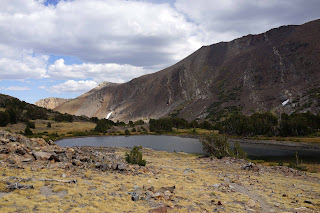Dale Matson
Click On Photographs To Enlarge
Sierra Nevada Bighorn Sheep Mt. Gibbs Herd Unit
I had the opportunity and honor to attend the two day field
seminar on the endangered Sierra Nevada Bighorn Sheep hosted by the Mono Lake
Committee http://www.monolake.org/mlc/mlc
and promoted by the Sierra Nevada Bighorn Sheep Foundation. http://sierrabighorn.org/
The $165.00 fee was a bargain and I told our instructor Dr.
John Wehausen that I would have paid that much if we had only a one-day
experience. We couldn’t locate any sheep on day two but had excellent hiking,
good instruction and beautiful settings in Lundy Canyon and Virginia Lakes.
I believe it is safe
to say that John Wehausen has contributed more to the successful
reestablishment of the SNBS than any other person. He has been involved with
the bighorn sheep for over 40 years and helped get the sheep included as an
endangered species. It was Dr. Wehausen who identified the Sierra Nevada
Bighorn Sheep as a distinct subspecies of bighorn sheep with 250 sheep in three
remaining herds in 1978. There were only 115 sheep remaining by 1995. In 1999
the Sierra Nevada Bighorn Sheep were listed as endangered. Dr. Wehausen
contributed to the recovery plan released in 2007. Since that time additional
herd units have been established in their traditional Sierra Nevada range with
about 600 sheep by 2014.
This was a rigorous field trip with fast paced hiking on and
off trail at high altitude. The 15 or so participants received instruction in
various locations along the trail with our highest ‘classroom’ on the southwest
slope of Mt. Gibbs (above Mono Pass) at 11,000’. Dr. Wehausen had used radio
collar telemetry to determine approximately where the sheep were and we climbed
off trail to get a closer look. Having the opportunity to once again see the
bighorn sheep (in this case about 11 ewes and lambs) was the best treatment for those
of us who suffer from recurring “bighorn fever”.
As an advocate for the sheep, I can understand why the
biggest impediment to support is that the sheep are essentially invisible. This
is an important defense for them but being invisible is not helpful in raising
awareness. Probably the single most helpful thing that can be done for the
sheep is more individuals becoming aware of and knowledgeable about their
existence. Increased awareness is one of the main goals of the Sierra Nevada
Bighorn Sheep Foundation.
The sheep seem to like living near beautiful views since the
search for them includes exquisite scenery. It was good weather and an
impressive group of supporters with whom to associate. Kudos to board member
Dr. Virginia Chadwick in her usual role as expediter, Dr. Wehausen for his
exhaustive knowledge about the sheep and their ecological niche and to Andrew
Youssef from the Mono Lake Committee who accompanied us on the first day.
Initial Session With Distinctions Made Between Sierra Nevada and Desert Bighorns
Regrouping At Mono Pass Trailhead
Instruction Along The Trail
"Higher Education" (11,000')
Summit Lake Mono Pass
Blue Lake (Virginia Lakes)
Lundy Lake Lundy Canyon
Evening Rain Over Mono Lake



















No comments:
Post a Comment